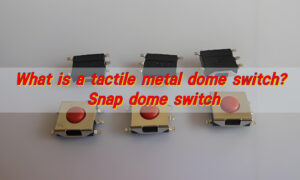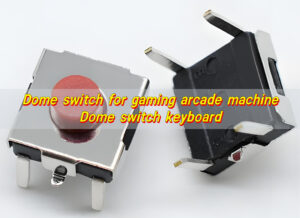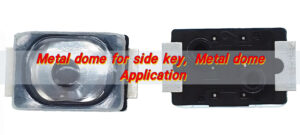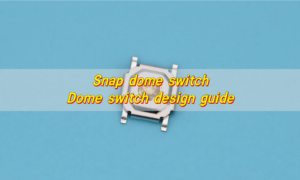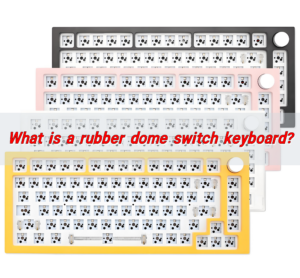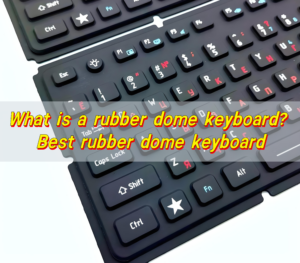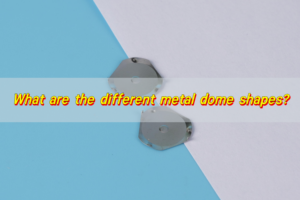Silicone dome switches are membrane switches whose elastic layer is made of silicone material with good flexibility and insulation. It deforms the silicone dome by pressing, contacts the circuit to achieve conduction, and provides comfortable tactile feedback. The weather resistance and temperature resistance of silicone make it suitable for harsh environments.
What are silicone dome switches?
Silicone dome switches are fundamental components in modern electronics. They belong to the category of membrane switches and are characterized by their unique design. A silicone dome switch consists of a dome – shaped piece crafted from high – quality silicone rubber. This dome is placed over a printed circuit board (PCB) with conductive traces.
When a user applies pressure to the key or button associated with the silicone dome switch, the dome collapses. This collapse causes the conductive layer on the underside of the dome to come into contact with the conductive traces on the PCB. Once this contact is established, an electrical circuit is completed, and the device registers the input.
How to wire a silicone dome tactile switch?
The PCB has specific contact points where the wires need to be connected. These contact points are designed to align with the conductive layer of the silicone dome. Carefully place the silicone dome on the designated area of the PCB, ensuring proper alignment.
Next, use a soldering iron to attach the wires to the contact points on the PCB. It is crucial to use the correct amount of solder. Insufficient solder may result in a weak connection, while excessive solder can lead to short – circuits.
After soldering, it is essential to test the switch. A multimeter can be used to check for continuity. Press the silicone dome, and if the multimeter indicates a closed circuit, the switch is wired correctly.
Are rubber dome switches better than mechanical?
Rubber dome switches are well – known for their quiet operation. When a key is pressed on a rubber dome keyboard, the sound produced is minimal. This makes them ideal for environments where noise is a concern, such as offices and libraries.
Additionally, rubber dome switches are more cost – effective to manufacture, which translates into lower – priced keyboards for consumers.
On the other hand, mechanical switches provide a more tactile and responsive feel. They have a distinct click and a well – defined actuation point. This makes them popular among gamers and typists who require precise control and rapid key presses. Mechanical switches also generally have a longer lifespan in terms of the number of keystrokes they can withstand.
If quietness and affordability are the primary concerns, rubber dome switches are a suitable option. However, for those who prioritize tactile feedback and durability, mechanical switches are the better choice.
What do rubber dome switches sound like?
Rubber dome switches produce a characteristic sound that is quite different from that of mechanical switches. When a key on a rubber dome switch is pressed, it emits a soft, muted sound. This sound is often described as a gentle thud.
The quiet nature of rubber dome switches is a significant advantage in many settings. In an office environment, it ensures that typing does not disrupt colleagues. At home, it allows for late – night use without disturbing others.
While some users may miss the audible click of mechanical switches, the quiet operation of rubber dome switches is highly valued in noise – sensitive environments.
Can rubber dome keyboards use custom keycaps?
The compatibility of rubber dome keyboards with custom keycaps depends on the design of the keyboard. Some modern rubber dome keyboards are designed with a standard keycap mounting system. These keyboards are more likely to be compatible with custom keycaps available in the market.
Custom keycaps come in a wide variety of colors, shapes, and materials. They can add a personal touch to the keyboard and enhance its aesthetic appeal.
However, many budget – friendly rubber dome keyboards have integrated keycaps. These keycaps are molded directly onto the switch mechanism, making it difficult or impossible to replace them with custom ones.
What’s the difference between rubber dome and membrane switches?
Although rubber dome switches are a type of membrane switch, there are notable differences between the two.
A rubber dome switch features a silicone or rubber dome that provides tactile feedback. When a key is pressed, the dome collapses and then rebounds, creating a distinct tactile sensation. This tactile feedback makes typing or using the switch more engaging and provides a sense of confirmation.
In contrast, a membrane switch uses a flat, flexible membrane. When pressure is applied to a key on a membrane switch, the membrane is pressed down to make contact with the conductive layer below. Membrane switches are generally thinner and more flexible than rubber dome switches.
In terms of feel, rubber dome switches offer a more pronounced tactile response. They feel more “clicky” or “bumpy” compared to the mushier feel of membrane switches. Rubber dome switches also tend to be more durable, as the dome structure can withstand a greater number of presses before showing signs of wear.
Is a rubber dome keyboard good for gaming?
The suitability of a rubber dome keyboard for gaming depends on the type of gaming and the player’s preferences.
For casual gaming, such as playing simple browser games or single – player role – playing games, a rubber dome keyboard can be a viable option. The quiet operation of the keyboard can be an advantage, especially in shared living spaces or during late – night gaming sessions.
However, for competitive gaming, a rubber dome keyboard may have limitations. Competitive gamers require a keyboard with fast response times and precise tactile feedback. Mechanical keyboards are generally preferred in this context, as they have a lower actuation force and a more distinct click, allowing for quicker and more accurate key presses.
Why choose a custom rubber dome keyboard?
There are several compelling reasons to opt for a custom rubber dome keyboard.
Customization allows for a keyboard that is tailored to specific needs. For example, users can choose the layout of the keys, which is particularly useful for those with unique typing requirements or for specialized applications. The size of the keyboard can also be customized, making it more portable or suitable for a particular workspace.
In addition to layout and size, the tactile feel of the keyboard can be adjusted. The actuation force and the amount of feedback can be customized to match the user’s typing or gaming style. This ensures a more comfortable and efficient user experience.
Conclusion:
Silicone dome switches operate via dome collapse, are reliable and cost – efficient. Wiring demands precision. Rubber dome switches are quiet and cheap compared to tactile mechanical ones. They make a soft sound, and keycap customizability varies.
If you have any further questions or need more information, please contact us at sales@metal-domes.com







